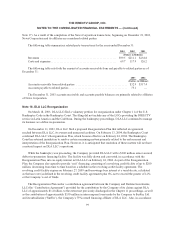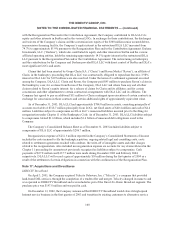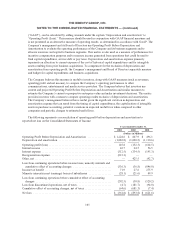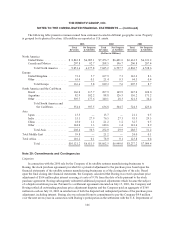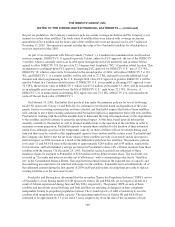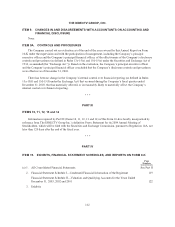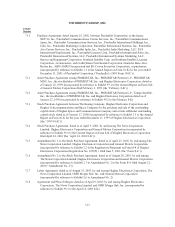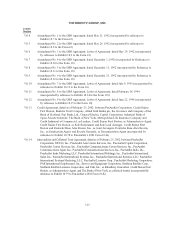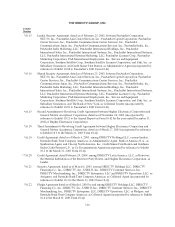DIRECTV 2003 Annual Report Download - page 115
Download and view the complete annual report
Please find page 115 of the 2003 DIRECTV annual report below. You can navigate through the pages in the report by either clicking on the pages listed below, or by using the keyword search tool below to find specific information within the annual report.THE DIRECTV GROUP, INC.
NOTES TO THE CONSOLIDATED FINANCIAL STATEMENTS — (continued)
the past are prohibitive, the Company’s insurance policies contain coverage exclusions and the Company is not
insured for certain other satellites. The book value of satellites that were insured with coverage exclusions
amounted to $726.0 million and the book value of the satellites that were not insured was $1,182.5 million at
December 31, 2003. The uninsured amount includes the value of five PanAmSat satellites for which policies
were not renewed in May 2003.
As part of an arrangement with Telesat Canada (“Telesat”), a Canadian telecommunications and broadcast
services company, DIRECTV U.S. agreed to provide Telesat, subject to FCC approval, the use of the DIRECTV
3 satellite, which is currently used as an in-orbit spare, through the end of its useful life and in return Telesat
agreed to allow DIRECTV U.S. the use of its 72.5 degrees west longitude (“WL”) Canadian orbital location. This
arrangement is contingent upon FCC approval. Assuming FCC approval for DIRECTV U.S.’ use of 72.5 WL,
DIRECTV 7S, which is expected to be launched in the second quarter of 2004, will replace DIRECTV 5 at 119
WL, and DIRECTV 5, or a similar satellite, will be relocated to 72.5 WL and used to provide additional local
channels and other programming in the U.S. through 2008. Once FCC approval is granted, DIRECTV 3 will be
used by Telesat in a Canadian orbital location. If DIRECTV U.S. is successful in obtaining FCC approval to use
72.5 WL, the net book value of DIRECTV 3, which was $77.8 million at December 31, 2003, will be reclassified
as an intangible asset and amortized over the life of DIRECTV U.S.’ right to use 72.5 WL. However, if
DIRECTV U.S. is unsuccessful in obtaining FCC approval to use 72.5 WL, DIRECTV U.S. will immediately
write-off the net book value of DIRECTV 3.
On February 19, 2003, PanAmSat filed proofs of loss under the insurance policies for two of its Boeing
model 702 spacecraft, Galaxy 11 and PAS-1R, for constructive total losses based on degradation of the solar
panels. Service to existing customers has not been affected, and PanAmSat expects that both of these satellites
will continue to serve these existing customers until PanAmSat replaces or supplements them with new satellites.
PanAmSat is working with the satellite manufacturer to determine the long-term implications of this degradation
to the satellites and will continue to assess the operational impact. At this time, based upon all information
currently available to PanAmSat, as well as planned modifications to the operation of the satellites in order to
maximize revenue generation, PanAmSat expects to operate these satellites for the duration of their estimated
useful lives, although a portion of the transponder capacity on these satellites will not be useable during such
time and there may be a need to offer supplemental capacity from another satellite in later years. PanAmSat and
the Company also believe that the net book values of these satellites are fully recoverable and do not expect a
material impact on 2004 revenues as a result of the difficulties with these two satellites. The insurance policies
for Galaxy 11 and PAS-1R were in the amounts of approximately $289 million and $345 million, respectively,
for total losses, and both included a salvage provision for PanAmSat to share 10% of future revenues from these
satellites with the insurers. On December 29, 2003, PanAmSat reached a partial loss settlement of these
insurance claims for payment to PanAmSat of $260 million with no future revenue share. The receivable was
recorded in “Accounts and notes receivable, net of allowances” with a corresponding reduction to “Satellites,
net” in the Consolidated Balance Sheets. This negotiated resolution balances the expected loss of capacity and
the remaining use expected to be achieved with respect to the satellites. PanAmSat received substantially all of
the settlement amount during the first quarter of 2004 and PanAmSat plans on using these proceeds to replace
existing satellites over the next several years.
PanAmSat and Boeing have determined that the secondary Xenon-Ion Propulsion Systems (“XIPS”) on two
of PanAmSat’s seven Boeing model 601 HP spacecraft, Galaxy 4R and PAS-6B, are no longer available as a
result of failures experienced during June and July 2003, respectively. The primary XIPS on each of these
satellites had previously ceased working, and both satellites are operating as designed on their completely
independent backup bi-propellant propulsion systems. The C-band capacity of G4R is backed up by in-orbit
satellites with immediately available capacity. The remaining useful lives on Galaxy 4R and PAS-6B are
estimated to be approximately 3.5 years and 4.9 years, respectively, from the date of the occurrence of each
108



